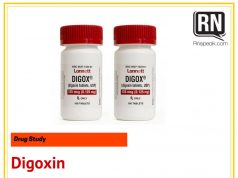
Generic Name:Metoclopramide
Brand Name:Clopra, Emex , Maxeran , Maxolon, Reglan
Classifications:gastrointestinal agent; prokinetic agent (gi stimulant); autonomic nervous system agent; direct-acting cholinergic (parasympathomimetic); antiemetic
Pregnancy Category:B
Availability
5 mg, 10 mg tablets; 5 mg/5 mL solution; 5 mg/mL injection
Actions
Potent central dopamine receptor antagonist. Structurally related to procainamide but has little antiarrhythmic or anesthetic activity. Exact mechanism of action not clear but appears to sensitize GI smooth muscle to effects of acetylcholine by direct action.
Therapeutic effects
Increases resting tone of esophageal sphincter, and tone and amplitude of upper GI contractions. As a result, gastric emptying and intestinal transit are accelerated with little effect, if any, on gastric, biliary, or pancreatic secretions. Antiemetic action results from drug-induced elevation of CTZ threshold and enhanced gastric emptying. In diabetic gastroparesis, indicated by relief of anorexia, nausea, vomiting, persistent fullness after meals.
Uses
Management of diabetic gastric stasis (gastroparesis); to prevent nausea and vomiting associated with emetogenic cancer chemotherapy (e.g., cisplatin, dacarbazine); to facilitate intubation of small bowel; symptomatic treatment of gastroesophageal reflux.
Contraindicatons
Sensitivity or intolerance to metoclopramide; allergy to sulfiting agents; history of seizure disorders; concurrent use of drugs that can cause extrapyramidal symptoms; pheochromocytoma; mechanical GI obstruction or perforation; history of breast cancer. Safety during pregnancy (category B) or lactation is not established.
Cautious Use
CHF; hypokalemia; kidney dysfunction; GI hemorrhage; history of intermittent porphyria.
Route & Dosage
Gastroesophageal Reflux
adult:PO 10–15 mg q.i.d. a.c. and h.s.
child:PO/IV/IM 0.4–0.8 mg/kg/d in 4 divided doses
Diabetic Gastroparesis
adult:PO 10 mg q.i.d. a.c. and h.s. for 2–8 wk
geriatric:PO 5 mg a.c and h.s.
Small-bowel Intubation, Radiologic Examination
adult:IM/IV 10 mg administered over 1–2 min
child:IM/IV <6 y, 0.1 mg/kg over 1–2 min; 6–14 y, 2.5–5 mg over 1–2 min
Chemotherapy-induced Emesis
adultchild:PO 2 mg/kg 1 h before antineoplastic administration, may repeat q2h for 3 more doses if needed
IM/IV 2 mg/kg 30 min before antineoplastic administration, may repeat q2h for 2 doses, then q3h for 3 doses if needed
Adverse effects:
CNS:restlessness,drowsiness,fatigue,insomia,dizziness,anxiety
CV:tansient hypertension
GI:nausea and diarrhea
Nursing Implications
Assessment & Drug Effects
- Report immediately the onset of restlessness, involuntary movements, facial grimacing, rigidity, or tremors. Extrapyramidal symptoms are most likely to occur in children, young adults, and the older adult and with high-dose treatment of vomiting associated with cancer chemotherapy. Symptoms can take months to regress.
- Be aware that during early treatment period, serum aldosterone may be elevated; after prolonged administration periods, it returns to pretreatment level.
- Lab tests: Periodic serum electrolyte.
- Monitor for possible hypernatremia and hypokalemia, especially if patient has CHF or cirrhosis.
- Adverse reactions associated with increased serum prolactin concentration (galactorrhea, menstrual disorders, gynecomastia) usually disappear within a few weeks or months after drug treatment is stopped.
Patient & Family Education
- Avoid driving and other potentially hazardous activities for a few hours after drug administration.
- Avoid alcohol and other CNS depressants.
- Report S&S of acute dystonia, such as trembling hands and facial grimacing,immediately.
- Do not breast feed while taking this drug without consulting physician.







